Secrets of growing Silver Dollar hydrangea - from planting to abundant flowering
Hydrangea Silver Dollar is another gem among paniculate species created in the new millennium. Yes, it lacked the aggressive marketing campaign of the Limelight hydrangea, but its beauty and unique properties make it a winner on the same level.
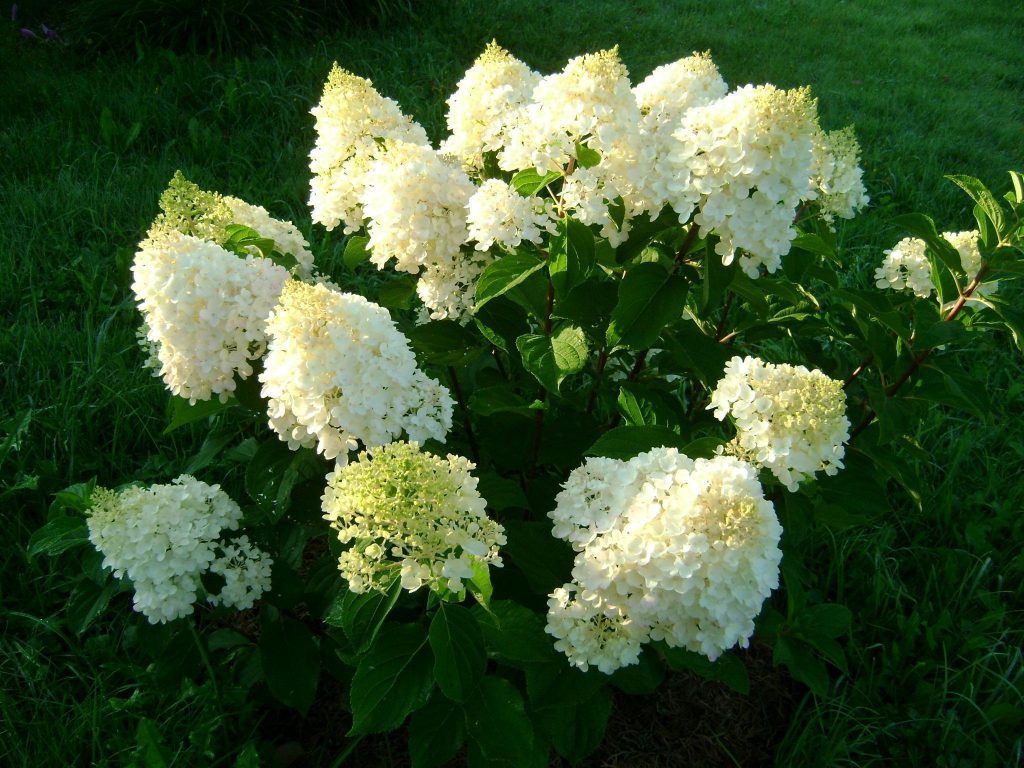
Hydrangea silver dollar photo
Description of the variety
The full name is Hydrangea paniculata Silver Dollar.
The cultivar, grown at the turn of the century by Dutch breeder Peter Zweinenburg, won the AGM (Award of Garden Merit) from the British Royal Horticultural Society in 2008 for outstanding decorative qualities, shape stability and disease resistance.
The highest mark, three points, was awarded to the flower for its popularity among European gardeners.
External parameters
Hydrangea Silver Dollar forms large (up to 25 cm) conical panicles, consisting mainly of sterile flowers (those with larger petals).
Light green flowers appear in mid-July, later changing to almost pure white, turning pale pink in late summer and early fall.
Panicles adhere well to strong crimson-brown stems in both wind and rain. The leaves are ovoid or oval, pointed, dark green, do not change color in autumn.
The shrub is compact, moderately growing, grows quickly, does not lie under the weight of massive inflorescences.
Bush sizes:
- height - up to 1.8 m;
- diameter - up to 1.5 m.
The correct natural shape, dense panicles, completely covered with large sterile flowers, long flowering - all this translates the Silver Dollar from an ordinary inhabitant of a flower garden into its main decoration.
Flowers stand perfectly in cut, retain their shape and color for a long time when dried.
Landing features
Panicle hydrangeas are found in the wild in southern Sakhalin, China and Japan. This is the most frost-resistant species of the hydrangea family. The plant forms panicles on the shoots of the current year, so even frosts down to -34 ° C do not damage flower buds.
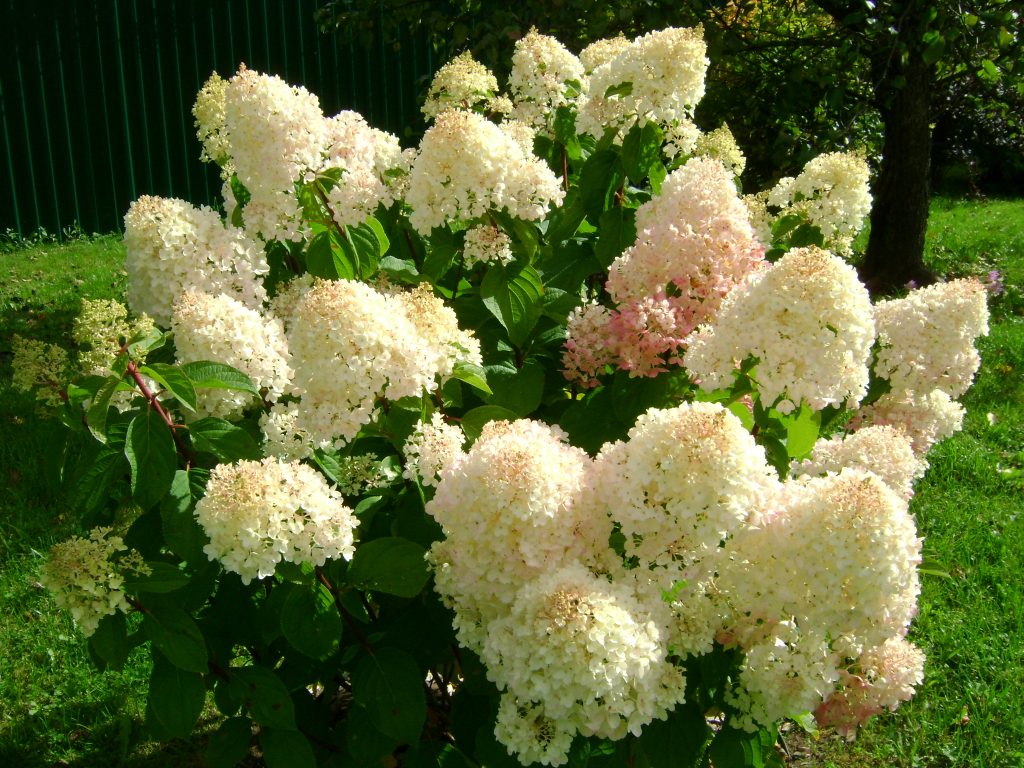
Hydrangea dollar silver
Unpretentious, growing on any acidic soil, undemanding to lighting, pan-hydrangea can only suffer from improper agricultural practices during cultivation.
Timing
Planting material is usually sold with a closed root system, so planting can be carried out during the entire period with an average daily positive temperature.
In Central Russia - this is the first half of May. At this time, the snow has already melted, the soil is suitable for cultivation, has warmed up to a depth of 10-15 cm, but has not yet lost the necessary moisture.
If planting is planned in the fall, then the only restriction is that the seedling for complete rooting must be planted a month before stable frosts.
Seat selection
A sunny warm area protected from drafts - an ideal place for hydrangeas.It's even better if there is a shadow there at noon.
Hydrangea does not like the direct midday sun: its large leaves quickly evaporate moisture, wither in the sun. She likes lace penumbra or sun in the early morning and after 3 pm more. With this kind of lighting, the decorative properties of the Silver Dollar will be fully manifested. Near the wall, near the fence, in the transparent shade of large trees - the most comfortable place for him.
Preparation of planting material
A good seedling has at least 2 shoots and a healthy root system free of mold and mildew. The roots should be firm, moist and not overdried.
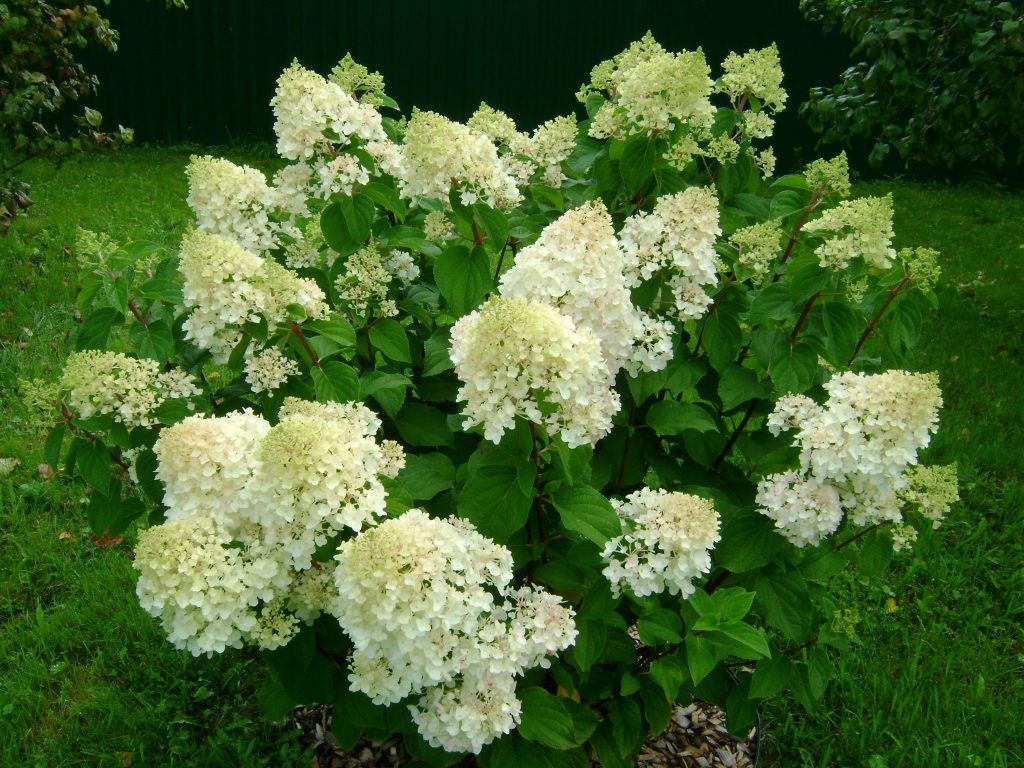
Hydrangea silver dollar photo and description
Leaves - with good turgor, bright green color. Spots, bumps on leaf plates and stems, cobwebs are signs of diseases or pests. Such copies must be resolutely discarded.
A seedling with an open root system (OCS) is soaked for several hours in a root stimulant solution before planting.
Landing technology
The root system of hydrangeas grows in breadth, not in depth. The planting hole should be sized so that the roots fit there in a straightened state. Its depth and width depend on the age and variety of the seedling, but usually it is 0.5 x 0.7 m.
The optimal composition of the soil for planting (in equal proportions):
- fertile loam that can retain moisture;
- high-moor peat;
- coniferous land;
- humus.
When planting, complex mineral fertilizers (NPK) are added. In spring - with a high proportion of nitrogen, in autumn - with a high content of potassium and phosphorus.
Acidity pH = 4.5-6. Alkalization causes chlorosis of the leaves.
Hydrangea is a moisture-loving plant, but it does not tolerate stagnation of moisture at the roots, this provokes their rotting. Waterlogged areas or areas with a close approach of groundwater will cause fungal diseases in the flower, such places should be avoided.
Landing Algorithm:
- The roots are shortened by 3-5 cm, the shoots are cut to 5-6 buds.
- Drainage must be laid at the bottom of the planting pit.
- Pour 10-20 cm of the prepared soil.
- Water abundantly.
- A seedling is placed with straightened roots (in the case of an ACS) or an earthen ball is installed from a container with an ACS.
- Cover with a fertile mixture so that the root collar remains at ground level.
- They are tamped and mulched with peat.
- Watering.
- Shade.
The seedling needs to be watered more often in the first 7-10 days, because the roots will not yet provide enough moisture to the plant.
Care
The Silver Dollar was highly praised by experts for its endurance. It can grow in the polluted city air, in small containers and in almost any type of soil, as long as it is not too heavy and shallow. But this does not mean that you do not need to look after him.
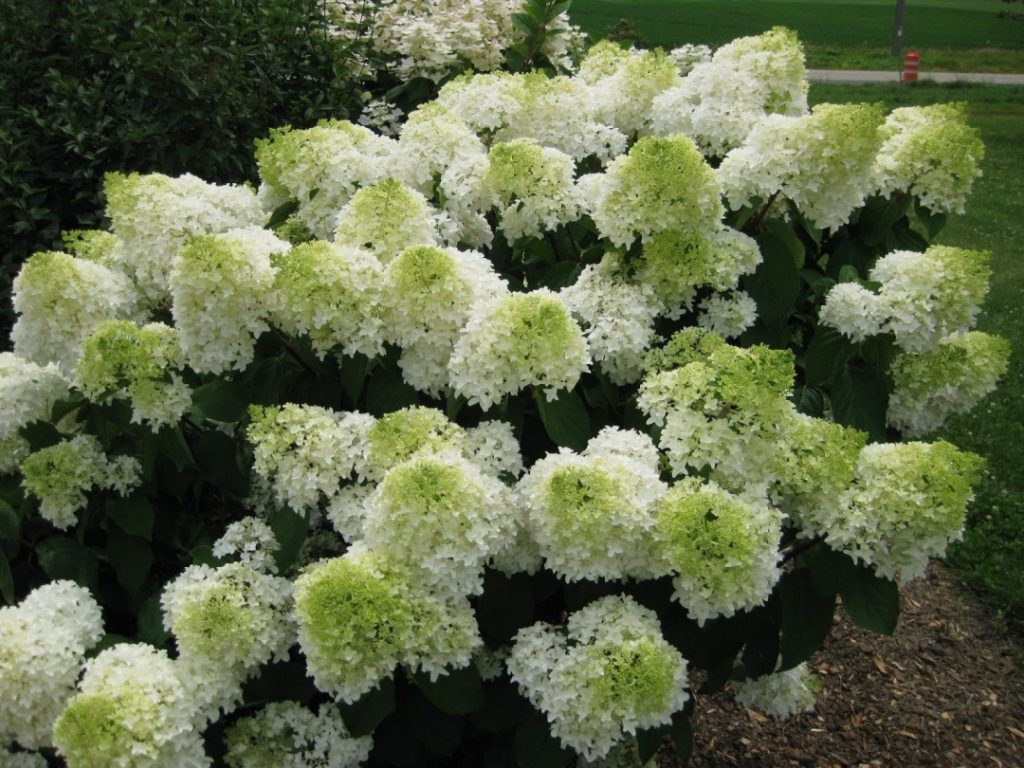
Hydrangea silver dollar description and photo
Watering
The soil should contain a lot of moisture, especially during flowering. The topsoil can be protected from drying out by mulching with pine bark. This will provide moisture and eliminate weeds.
Young plants most often suffer from drought, the roots of which have not gone deep enough into the aquifers of the soil.
The Silver Dollar quickly recovers from a short-term drought, but in hot weather it needs abundant watering - at least 8-10 liters per bush.
Top dressing
Fertilization for hydrangeas is extremely important: strong bushes, abundant flowering require a lot of nutrients. Starting from spring, every month, until the end of June, it is fed using multicomponent mineral fertilizers without calcium content. You can fertilize the bushes with manure or compost. Fertilizers are spread under the bushes, mixing it with the soil. A specialized fertilizer for this flower should contain about 2% nitrogen (N), 1% phosphorus (P2O5) and 2% potassium (K2O).
2-3 weeks before budding (end of June), a large dose of phosphorus is included in the fertilizer - so the flowering will be more abundant and longer.
After that, potassium should prevail in the dressing - it will help prepare the bushes for winter.At this time, nitrogen is excluded from the mineral mixtures.
During the entire growing season, hydrangea responds well to acidic feeding. Suitable for this:
- an aqueous solution of citric acid (1 g per glass of water);
- any fermented milk product diluted with water in a 1: 1 ratio;
- a decoction of spruce cones and needles.
Pruning
Pruning is an essential element of hydrangea care., which is held several times a season.
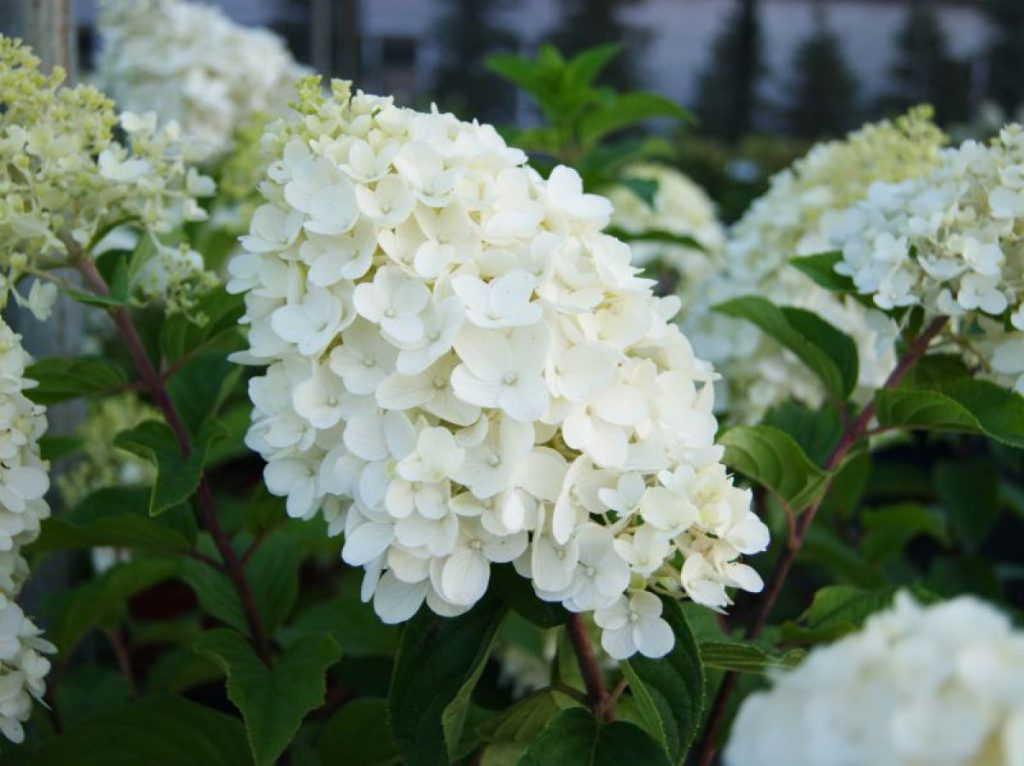
Silver dollar hydrangea paniculata
- At the turn of March and April, before the active movement of the juice, begin cutting, leaving no more than 5 buds on the stem. Silver Dollar forms inflorescences on the shoots of the current year, so early pruning allows you to lay large beautiful brushes. By removing all damaged and weak shoots, they create the shape of the plant. If this is not done, the bush will look untidy, with small panicles.
- In summer pruning is carried out for thinning. In this case, the shoots growing inside are removed. These actions promote the formation of new shoots and flowers.
- In autumn another pruning is needed, which prepares the flower for cold and snow: they remove withered inflorescences and damaged stems. Otherwise, the bush may bend under the weight of a snowdrift and break.
- Late autumn anti-aging (rejuvenating) pruning. Get rid of old shoots immediately after flowering. They are cut out at the root, and the places of the cuts are sprinkled with earth. In spring, new shoots appear, providing abundant flowering.
Preparing for winter
If the winter in your area is too harsh and snowless, then the bushes need protection. Hydrangea silver dollar is also recovering after frost at 34 ° C, but for normal flowering next year it is better to take care of its roots.
For this:
- the trunk circle is mulched with dry leaves, peat, spruce branches. Biologists of the US National Arboretum recommend placing food foil on top of the mulch (such a shelter saved the bush from Canadian frosts at -40 ° C);
- a frame of boards is created above the bush, and it is covered with lutrasil.
Reproduction
The Silver Dollar panicle hydrangea reproduces in several ways. The gardener can choose the most convenient for himself:

Hydrangea paniculata silver dollar
- In spring or autumn, the plant can be propagated. by dividing the bush... To do this, they dig it out, trying not to damage the roots. Then they are divided into several parts so that each has 2-3 kidneys. Prepared bushes are planted in a hole and watered well. Many manufacturers carry out dividing without digging, for which they free a piece of land with a shovel or pitchfork at a distance of about 15 cm from the bush. The plant is tilted to the ground and several parts of the root with buds are cut from it.
- Most effective and a simple method is considered grafting. Medium-sized annual shoots are prepared (they root better). Small cuttings with 2-3 leaf knots are cut from the branches. They need to be treated with a growth stimulant and planted in moist soil, consisting of equal parts of sand and peat. The cuttings are covered with glass jars on top and left in a dark room. It is necessary to monitor the moisture content of the soil. When the first roots appear, the container needs to be rearranged to a bright place. To harden plants with the arrival of spring, they should be placed on the balcony. In open ground, hydrangea is planted after the appearance of the leaves.
- Another breeding method is dropping. To do this, at the beginning of spring, it is necessary to carefully cut off the bark from the shoot of the last year, treat the growth area with a growth stimulator, tilt it to the ground, deepening it by 2-3 cm. Top it up with soil 3 cm high. Make sure that the top of the shoot is 18-22 cm remains outside, and the kidneys are in the ground. The next year, cuttings are cut from the mother bush and transplanted to a permanent place.
- Seed propagation is a laborious method that is not always effective and is used more often by breeders than by amateur producers.
Diseases and pests
Hydrangeas are disease resistant plants.But improper care and landing in the wrong place can cause problems:

Panicle hydrangea silver dollar
- A substrate with too high soil pH can cause leaf chlorosis.
- Lack of nutrients in the soil is manifested by spots on the leaves, lack of growth and wilting of the plant. Symptoms can also indicate fungal infections.
- An improperly chosen place with intense insolation from direct sunlight leads to leaf burns.
- Lack of protection from cold gusts of wind and improper pruning can inhibit the formation of inflorescences.
Hydrangea is affected by infections:
- gray mold;
- leaf spot;
- powdery mildew.
The affected parts of the bush should be quickly cut and burned. Spraying with drugs - fungicides helps in the fight against diseases.
Use in landscape design
Silver Hydrangea is a multi-leaved deciduous shrub with a more or less rounded shape. It is great for small gardens, backyards and loggias. Its relatively coarse texture can be used to highlight landscape plants with thinner foliage.

Hydrangea silver dollar
Ephedra, azaleas, rhododendrons, which also prefer acidic soil, form an excellent mixborder with 3-5 hydrangea bushes.
Silver Dollar is suitable for planting in oriental and mixed style gardens, for growing in pots and on a trunk.
This view will show itself perfectly:
- as a tapeworm against the background of an even lawn;
- as a secondary plant in mass plantings;
- in multilevel compositions of a romantic or nostalgic style.
40 years - this is the life span of a hydrangea her breeder promises. And this means the stability of landscape compositions is ensured!
Testimonials
Owners of small household plots note the compactness of the variety. It, unlike other large-flowered hydrangeas, does not require much space and any props. Flowering cones are held on strong stems, the bush does not "fall apart" under their weight.
Novice amateur landscapers noticed the peculiarity of Silver Dollar - its stems are devoid of leaves to a height of 15-20 cm from the ground, so short annuals look good next to it: tulips, muscari, asters, lobelia. And the standard form makes you freeze with delight!
Flower growers love the long bloom of the Silver Dollar. At the end of October, the garden has already faded, and only the creamy Silvera hats adorn it.
Lovers of dry bouquets are happy to insert dried SilverDollar inflorescences into their compositions - they do not lose their shape and color when dried.
All owners of this variety have noticed its resistance to adverse conditions and care errors.
"The variety has no negative characteristics" - with this conclusion of the experts of the English Royal Society of Gardeners, all who decided to plant this little beauty under their windows agree.


